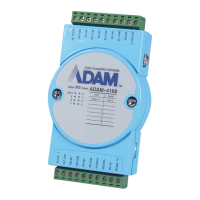Chapter 2
Chapter 2 installation Guideline 2
-7
Changing the protocol from ADAM ASCII to Modbus
Some ADAM-4100 modules support both ADAM ASCII and Modbus
protocols, and the factory default setting of these modules is ADAM
ASCII protocol. If you would like to configure the modules to Modbus
protocol, please refer to Appendix G which describes how to change the
protocol in ADAM utility.
Configuration with the ADAM command set
ADAM modules can also be configured by issuing direct commands
through a terminal emulation program that is part of the ADAM utility
software. Please refer to Chapter 4 to know more details.
2.3 Baud rate and Checksum
Adam modules contain EEPROMs to store configuration information
and calibration constants. The EEPROM replaces the conventional
array of switches and pots that are originally used for specifying baud
rate, input and output range… etc.
Since there is no visual indication of a module’s configuration status, it
is impossible to know the baud rate, address and other settings just by
looking at it. It might not be possible to establish communications with
a module whose baud rate and address are unknown. To overcome this
problem, every module has an input terminal labeled INIT*. Booting
the module while connecting the INIT* switch forces the configuration
into a known state called the INIT* state.
INIT* state defaults:
Baud rate: 9600
Address: 00h
Checksum: disabled
Forcing the module in INIT* state does not change any parameters in
the module’s EEPROM. When the module is in the INIT* state, all
configuration settings can be changed, and the module will respond to
all other commands normally.

